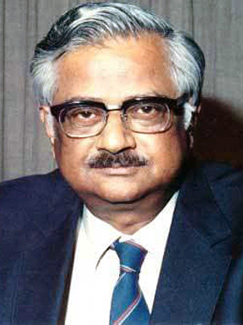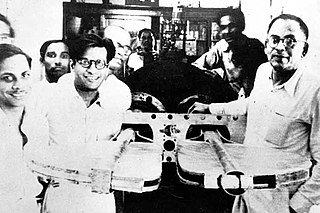
Ashoke Sen FRS is an Indian theoretical physicist and distinguished professor at the International Centre for Theoretical Sciences (ICTS), Bangalore. A former distinguished professor at the Harish-Chandra Research Institute, Allahabad, He is also an honorary fellow in National Institute of Science Education and Research (NISER) India he is also a Morningstar Visiting professor at MIT and a distinguished professor at the Korea Institute for Advanced Study. His main area of work is string theory. He was among the first recipients of the Breakthrough Prize in Fundamental Physics "for opening the path to the realization that all string theories are different limits of the same underlying theory".

Meghnad Saha was an Indian astrophysicist who helped devise the theory of thermal ionisation. His Saha ionisation equation allowed astronomers to accurately relate the spectral classes of stars to their actual temperatures.

Raja Ramanna was an Indian nuclear physicist. He was the director of India's nuclear program in the late 1960s and early 1970s, which culminated in Smiling Buddha, India's first successful nuclear weapon test on 18 May 1974.

Mambillikalathil Govind Kumar Menon also known as M. G. K. Menon, was a physicist and policy maker from India. He had a prominent role in the development of science and technology in India over four decades. One of his most important contributions was nurturing the Tata Institute of Fundamental Research, Mumbai, which his mentor Homi J. Bhabha founded in 1945.

Anil Kakodkar, is an Indian nuclear physicist and mechanical engineer. He was the chairman of the Atomic Energy Commission of India and the Secretary to the Government of India, he was the Director of the Bhabha Atomic Research Centre, Trombay from 1996 to 2000. He was awarded the Padma Vibhushan, India's second highest civilian honour, on 26 January 2009.
Education in West Bengal is provided by both the public sector as well as the private sector. Health Sciences, University of North Bengal and University of Calcutta.

The Saha Institute of Nuclear Physics (SINP) is an institution of basic research and training in physical and biophysical sciences located in Bidhannagar, Kolkata, India. The institute is named after the famous Indian physicist Meghnad Saha.
Kandi is a sub-divisional city and municipality in Murshidabad district in West Bengal, India. It is the headquarters of the Kandi subdivision and is located on the east bank of Kana Mayurakshi River. The town is known for being one of the oldest municipal bodies in India, having acquired municipality status in 1869. The area is also known as the 'rice store' of Murshidabad district, owing to its large production of rice.

Bikas Kanta Chakrabarti (born 14 December 1952 in Kolkata is an Indian physicist. At present he is INSA Scientist at the Saha Institute of Nuclear Physics & Visiting Professor at the Indian Statistical Institute, Kolkata, India.

Basanti Dulal Nag Chaudhuri was an Indian Nuclear scientist and academic, and Scientific Advisor to the Ministry of Defence, Government of India. He is known as one of the pioneers of nuclear physics in India. While serving as the Director General to the Defence Research and Development Organisation (DRDO), he played influential role in Pokhran-I , India's first successful Nuclear bomb test on 18 May 1974. He also initiated the first feasibility studies on India's ballistic missile program.
Palle Rama Rao FREng is an Indian scientist noted for his contribution to the field of Physical and Mechanical Metallurgy. He has collaborated and conducted research activities for over dozen universities and associations all over India and abroad. He has been honoured with the titles of Padma Vibhushan in 2011 by president of India for his contributions to scientific community. He is acting as the chairman, Governing Council, International Advanced Research Centre for Powder Metallurgy & New Materials (ARCI), Hyderabad.
Krishnendu Sengupta, is a professor of theoretical physics in Indian Association for the Cultivation of Science (IACS), Kolkata, India, who was awarded the Shanti Swarup Bhatnagar Prize for science and technology, the highest science award in India, for the year 2012 in physical science category. Before joining IACS he was a research fellow in Harish Chandra Research Institute, Allahabad, and associate professor in Saha Institute of Nuclear Physics, Kolkata. He received his PhD from University of Maryland at College Park and MSc degree from Indian Institute of Technology, Kharagpur.
Sanghamitra Bandyopadhyay is an Indian scientist specializing in computational biology. A professor at the Indian Statistical Institute, Kolkata, she is a Shanti Swarup Bhatnagar Prize winner in Engineering Science for 2010, IInfosys Prize 2017 laureate in the Engineering and Computer Science category and TWAS Prize winner for Engineering Sciences in 2018. Her research is mainly in the areas of evolutionary computation, pattern recognition, machine learning and bioinformatics. Since 1 August 2015, she has been the Director of the Indian Statistical Institute, and she would oversee the functioning of all five centres of Indian Statistical Institute located at Kolkata, Bangalore, Delhi, Chennai, and Tezpur besides several other Statistical Quality Control & Operation Research Units spread across India. She is the first woman Director of the Indian Statistical Institute. Currently she is on the Prime Ministers' Science, Technology and Innovation Advisory Council. In 2022 she was given the Padma Shri award for Science and Engineering by the Government of India.

Valangiman Subramanian Ramamurthy is an Indian nuclear physicist with a broad range of contributions from basic research to Science and Engineering administration.Prof.Ramamurthy started his career in Bhabha Atomic Research Centre, Mumbai in the year 1963. He made important research contributions in the area of nuclear fission, medium energy heavy ion reactions, statistical and thermodynamic properties of nuclei and low energy accelerator applications. During the period 1995-2006, Prof.Ramamurthy was fully involved in Science administration as Secretary to Government of India, Department of Science and Technology, (DST), New Delhi.Other important assignments held by him include Director, Institute of Physics, Bhubaneswar, (1989-1995), DAE Homi Bhabha Chair in the Inter-University Accelerator Centre, New Delhi (2006-2010), and Director of the National Institute of Advanced Studies, Bengaluru (2009-2014). He is a former chairman of the Recruitment and Assessment Board of the Council of Scientific and Industrial Research and has served as a member of the design team of the first Indian nuclear experiment in Pokhran on 18 May 1974. The Government of India awarded him the third highest Indian civilian honour of Padma Bhushan in 2005.
Satinder Kumar Sikka was an Indian nuclear condensed matter physicist, crystallographer and a former Scientific Secretary to the Principal Scientific Advisor of the Government of India. He was known to have played a crucial role, along with Raja Ramanna, Rajagopala Chidambaram and Basanti Dulal Nagchaudhuri, in the design and development of a Hydrogen Bomb by India, which was tested at the Pokhran Test Range in May 1998, under the code name, Operation Shakthi. He was also involved in the Smiling Buddha tests, conducted in 1974. He was awarded the fourth highest civilian award of the Padma Shri, by the Government of India, in 1999.
Trilochan Pradhan was an Indian scientist.
Aninda Sinha is an Indian theoretical physicist working as a professor at Center for High Energy Physics, Indian Institute of Science in Bangalore, India.
Narendra Kumar was an Indian theoretical physicist and a Homi Bhaba Distinguished Professor of the Department of Atomic Energy at Raman Research Institute. He was also an honorary professor at Jawaharlal Nehru Centre for Advanced Scientific Research.
Biswarup Mukhopadhyaya is an Indian theoretical high energy physicist and a senior professor at Indian Institute of Science Education and Research, Kolkata. Known for his research on High energy colliders, Higgs bosons, neutrinos, Mukhopadhyaya is an elected fellow of the National Academy of Sciences, India. The Council of Scientific and Industrial Research, the apex agency of the Government of India for scientific research, awarded him the Shanti Swarup Bhatnagar Prize for Science and Technology, one of the highest Indian science awards, for his contributions to physical sciences in 2003.

The University College of Science, Technology and Agriculture are two of five main campuses of the University of Calcutta (CU). The college served as the cradle of Indian sciences by winning the Nobel Prize in Physics in 1930 and many fellowships of the Royal Society London.










